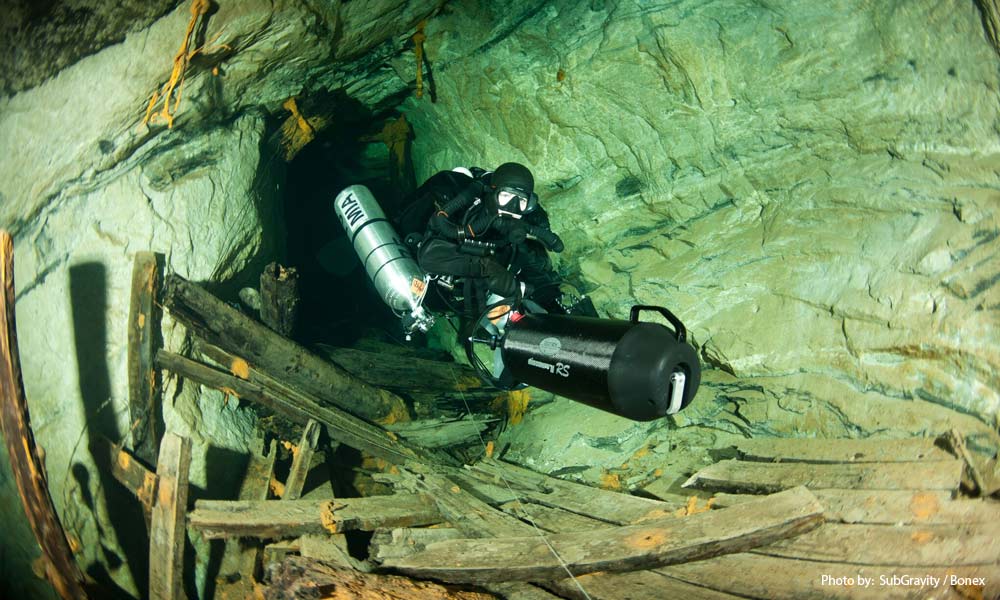Caves and DPV’s: What You Should Know
by Josh Thornton and Michael Thornton:
DPV (aka “scooter”) riding is fun and extends your range and capabilities. A DPV can allow you to travel to places that would otherwise be unreachable, or impractical to reach, but it also introduces additional complexities. Similar to rebreathers, when used properly in the right hands, a DPV can be a valuable tool for cave diving and exploration.
With a DPV, as with overhead environments and rebreathers, a diver must master the basics first and foremost. Formal DPV courses (such as those offered by TDI) are the most effective processes to learn certain safety procedures and other basics of piloting a DPV. As with most skills, it is an art, and best learned from someone who has a great deal of experience and professional training. This will accelerate your mastery of the most basic skills, smoothing out the learning curve and in the end, save you time, trouble and most likely money as well.
So what is so special about taking a DPV into a cave? Just as moving from open water to a cave presents specific challenges, so does taking a DPV from open water into a cave. Once the actual dive skills have reached a certain level of mastery (as required by the proposed dive), it all comes back to the basics of DPV dive planning – which turns out is not so “basic” after all.
- Estimating dive times
- Estimating DPV travel times
- Estimating DPV gas requirements
- Estimating task time requirements
- Estimating task gas requirements
- Estimating penetration gas totals
- Estimating time totals
- Planning/Preparing for a failure (time, gas, energy, deco, stress, navigation, silt, etc.)
There is a reason that almost all of the above bullet points begin with “estimating”. It takes a lot of practice to refine the above planning points in DPV cave diving. The primary danger with using a DPV in a cave is the possibility of traveling long distances into an overhead environment, having the DPV fail (for whatever reason) and not having a sufficient gas supply to safely exit the cave.
Additional complexities and additional hazards present themselves when piloting a DPV in a cave. These should be covered between your basic DPV course and your DPV cave course. We completed a quick survey with some of our DPV cave diving buddies, and compiled the following suggestions to help you prepare for DPV cave diving:
“Keep your eye on the gold line! You’ve heard that somewhere before, haven’t you? Seriously, keep your eye on the gold line! Modern DPVs are so powerful and fast, you can get yourself into serious trouble if you are not paying attention 100% of the time.”
“When I first started diving my DPV I was not comfortable with, or capable of, effectively using my light head in my left hand. If I had practiced more with my light, maybe switching from hand to hand, I would have had an easier time”
“As a cave diver, I know trim and streamlining are important, but as a DPV cave diver it is even more important. Any equipment that causes drag will now be exaggerated. Any issues with poor trim will now be exaggerated. Take the time to get these fundamental skills under control before adding complex DPV cave dives to the mix.”
“Take the time to properly adjust the trim and ballast on your DPV. DON’T BE LAZY! It will come back to bite you later on, believe me. Some DPVs come weighted and trimmed better than others; take your time to do some research as well as testing it for yourself.”
Josh Thornton – TDI IT
Michael Thornton – TDI IT
Josh and Michael are active CCR cave and DPV instructors for Dive Addicts, a 5 Start TDI Professional Development Center. They enjoy cold water, alpine cave exploration in their free time (only because they haven’t found any local warm water caves!). Their manufacturing and distribution company, SubGravity, is the exclusive distributor for Bonex DPVs in North and South America.


댓글을 남겨주세요
토론에 참여하시겠어요?언제든지 참여하세요!